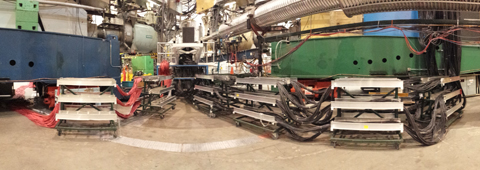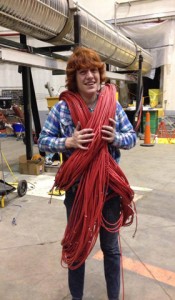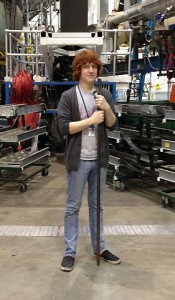By Robert Radloff
B.S. Physics, Class of 2016
I worked with Dr. Julie Roche on a particle physics project at the Thomas Jefferson National Accelerator Facility (JLab) in Newport News, VA. The goal of most experiments conducted at this facility, including the one I prepared, is to understand the force that holds the constituents of the proton together, a force that is responsible for 99.9 percent of the mass of the visible matter making up the universe.
Dr. Roche had me test out a new idea for detecting high energy photons produced during Deeply Virtual Compton Scattering (DVCS) off a hydrogen target. During DVCS scattering, she said, about one high energy photon is produced for every 1000 low energy photons. Being able to select the photon of interest among the noise is essential to the success of the DVCS experiment. So I explored a backup solution to be used should the primary system fail.
A big challenge was learning to program in ROOT-cern, a programming language designed for particle physics. I needed to use this language to work with the detector. I overcame it by diving in head first and learning using data from runs in 2010.
I met with Dr. Roche nearly every morning to discuss where my programs should be going, and any issues I had. In my spare time away from the lab, I socialized with the interesting people housed at the facility, attended research presentations of JLab scientists, and went to the beach occasionally.
I learned about how large scale, group experiments function first hand, and I learned how to use an entirely new programming language. The best thing about my experience was getting to explore the lab full of truly massive, and awe-inspiring scientific equipment. At the same time, I realized I had contributed a small piece of my own work, contributing in a very small way to an impressive experiment.

A panorama I took of the DVCS calorimeter ready for data taking in position in Hall A. The small black box at the center of the picture is the calorimeter. The picture also shows the two large magnetic spectrometers seating on the green stand (right) and on the blue stand (left). For DVCS, we only use the spectrometer seating on the green stand. For this picture, the electron beam proceeds from the back of the picture to the right top corner. The beam exits the hall through the pipe shown on the right top corner of the picture. The beam impinges on a liquid hydrogen target that is not on the picture but would it be here would be hidden by the DVCS calorimeter. My internship was supported by the National Science Foundation under Grant Award #1306376.
Robert Radloff – Intern with Dr. Julie Roche – junior at Ohio University – College of Arts & Sciences – physics major





















Comments